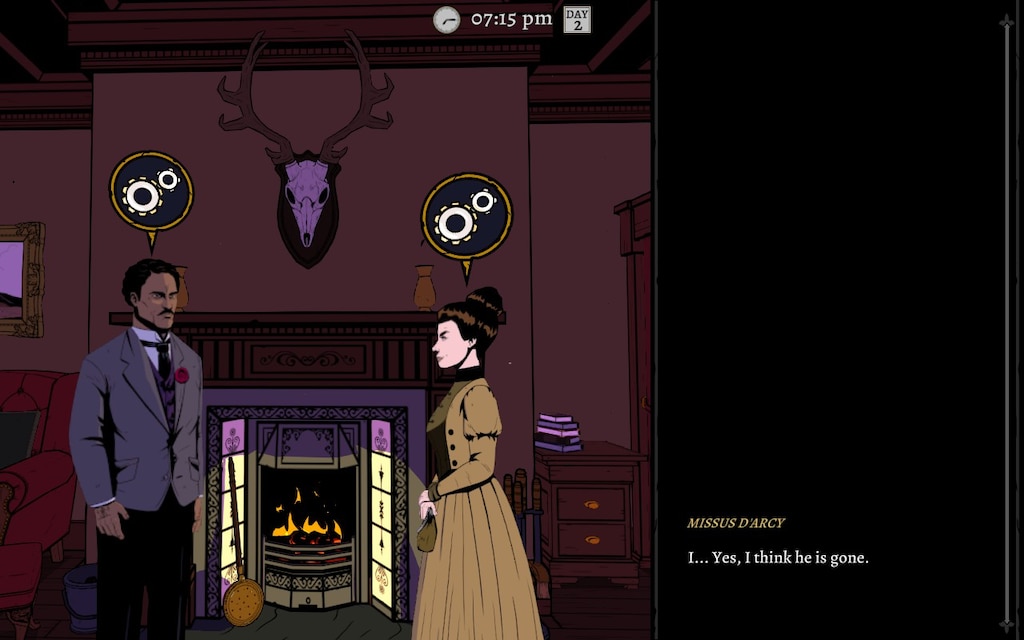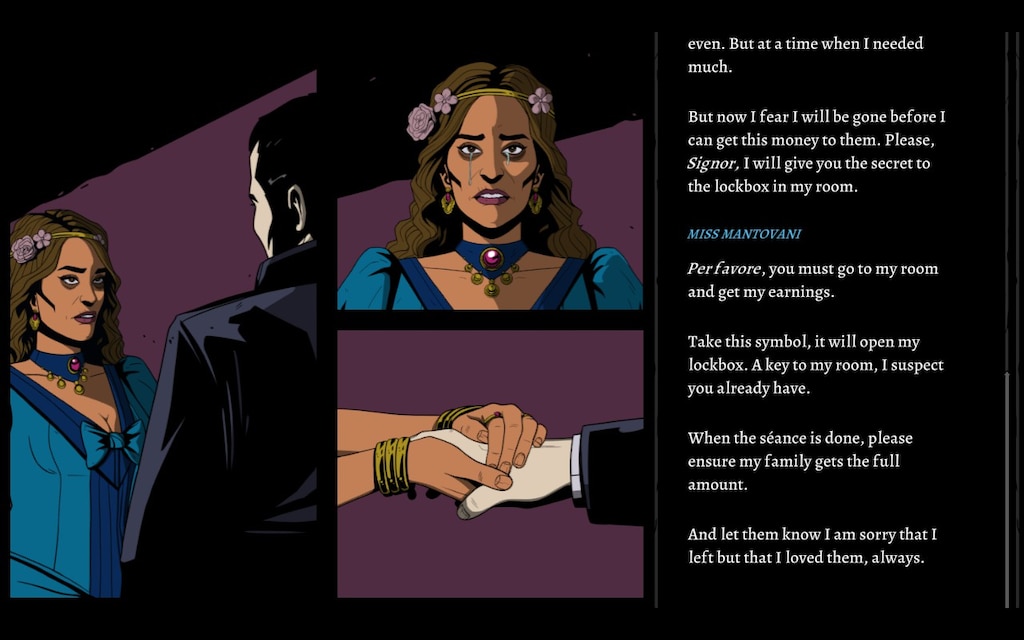
I rolled credits on Spooky Doorway’s The Seance at Blake Manor last week and was thoroughly impressed by the narrative, gameplay loop, and the ways it interweaved Irish mythology with late 19th-century mysticism. It’s absolutely in my top candidates for Game of the Year for 2025, and I found myself absolutely gripped by the setting, the characters, and puzzling out how to unravel the intricate, yet approachable, mysteries of the game’s core premise. As soon as I started delving into the central “loop” I instantly knew I wanted to complete and uncover as much as I could, and eagerly started plotting and mapping out my in-game time to ensure that I didn’t waste valuable minutes on any superfluous distractions.
What really stood out to me was how the story of Blake Manor is so wonderfully crafted. Not only does it accomplish what a lot of so-called “narrative-focused” games struggle with (making direct links between narrative and gameplay), but it also tells a story so rich with detail and characterization. I kept marveling at moments that initially felt like tangents looping back into central story lines. Details that at first felt throw-away later became a central pillar for investigation. Moments seemingly said in passing would become resources the player could utilize to solve mysteries, gain new information, or unlock hidden secrets. One character’s casual hobby became a key to unlock a deeper curiosity held by another NPC.
The overlapping storylines of Blake Manor are its true achievement. How seemingly disparate characters become pivotal to one another in meaningful and powerful ways in a true masterstroke of writing and design.
Compliments aside, folks studying or interested in game/narrative design might be asking why the writing structure of Blake Manor “works” so effectively. And although I’m asking why, one could also certainly ask how the complexity of this game’s narrative unfolds in such a frictionless and gratifying way. It accomplishes this feat through cleverly relying on character interdependence and, most importantly, shared stakes.

**~suffice to say that from here on out there will be some spoilers~**
After settling into your room and arriving at the Manor, the game truly gets underway when you start the first full day and encounter all of the guests gathered in the atrium after a raven has smashed through a skylight. Aside from being an unsettling harbinger of things to come, you are given your first glimpse at all the characters at once. Immediately following this, you are approached by Mr. Toussaint, who keenly observes that you might be an unwelcome outsider to this intimate, mystical gathering. To prevent him from “giving up the ghost” (lol), he enlists your detective skills to out one of the other guests as a charlatan. This initial investigation unlocks the central “loop” of the game, where you talk with guests, ask them about clues you’ve gathered, investigate their rooms, and confront them about their motivations/secrets. In this instance, you quickly surmise that Ms. Erickson is indeed a fraud and report back to Mr. Toussaint her confession.
This excellent onboarding of the player to the central mechanical procedures of the game is, in itself, worthy of analysis for aspiring designers, since it concisely and expertly sets the stage for what the player should expect from this experience. BUT, it’s also a fantastic showcase of how the narrative relies on mutual needs to execute its intricate overlapping story. Toussaint is tied to Erickson, and solving their individual mysteries (and ruling them out as potential kidnappers of Evelyn Dean, whom you are hired to find) requires resolving shared goals.
In this initial investigation, Mr. Toussant’s desire to hunt down phony magical practitioners is tied to Ms. Erickson’s pursuit at all costs to obtain magical ability. To complete this “quest,” you convince Ms. Erickson to forgo sacrificing her soul for mortal magic. Ms. Erickson’s reconsideration fulfills Mr. Toussaint’s quest ot find an imposter. These shared stakes provide the backbone for the intricate story arcs that twist and overlap throughout the entirety of Blake Manor’s story. Though this mystery is laid bare to the player (for tutorializing and onboarding), the game opens up after this, and the player is then tasked with managing how to navigate their investigations against the pending doom of the Seance at the end of the weekend.

In traditional quest design, NPCs present tasks to the player that, once completed, offer some reward: gold, items, information, access, story, etc. In Blake Manor, the quests are labeled “mysteries” that generally work toward finding Evelyn Dean. To complete these central quests, you go through a process of eliminating suspects who might’ve kidnapped Ms. Dean and gain a deeper understanding of their motivations for being at the Seance. However, where typical quest design telegraphs to the player their reward, Blake Manor doesn’t explicitly say what can be gained by eliminating NPCs and discovering their secrets. However, you quickly find that completing these seemingly secondary quests brings you closer to completing the central goal.
To fully “unlock” the mysteries of the NPCs (which, again, help with the central quest) you must discover how each character is interconnected. Only by pursuing these links―asking the doctor about a medication, asking a historian about a fugitive’s bloodline, asking the stable-hand about a former employer, talking to the failed entrepreneur about his admiration of the recently deceased mistress of the manor―are you able to solve the mysteries set before you. Often, these connections require some critical thinking. However, you can also see how certain clues or discoveries can be a topic of discussion with seemingly unrelated characters. Mapping out these connections is central to the gameplay loop, and you begin to see patterns and relationships merely by following your curiosity and collecting clues.
What’s most impressive about these interconnected stories is how they scale. It would be noteworthy to craft overlapping stories from a handful of NPCs (and to group them into some kind of RPG party), but Blake Manor does this with 24(ish) guests! Not all NPCs have narrative relationships, and many are paired off or grouped into triplets. But nearly all NPC mysteries require you to talk to multiple guests to do some creative/critical cross-examination. An elderly Priest might be able to talk about the parish’s adoption of a housekeeper’s child, but the two characters’ mysteries are not inherently intertwined. Solving mysteries (or completing quests) requires a deep immersion in the interconnected motivations, personalities, and particularities of ALL of the characters.

In this way, no character feels extraneous or underdeveloped, AND perhaps most remarkably, characters actually develop over the course of your gameplay. Potentially hostile or mercurial first encounters don’t fix characters to static personalities. Likewise, pleasant and seemingly harmless fuddy-duddies emerge to be complicated, duplicitous, ego-maniacal figures. The way the game constantly requires the player to renegotiate their relationship with the NPCS by actively learning about their motivations is such a wonderfully clever narrative technique. But tying that character development across and between NPCs is undeniably masterful.
Through crafting shared stakes, the narrative keeps folding back onto itself, which makes the experience of unfolding its intricacies all the more enjoyable and engrossing. But beyond gameplay and storytelling, this interconnectedness shows how society (even in the micro-form of the gathering for the Seance) is built on messy, complicated, and difficult shared histories. Where individuals are often told to be wary of those messy relationships, Blake Manor contends that the only way to repair the wounds of the past is to work together. The game shows this mechanically and narratively, revealing how skepticism, cynicism, blind bigotry, and artificial barriers based on class can all be overcome by talking to your community, laying bare your wishes, and working alongside one another to find solace, resolution, and eventually some sense of peace.

Leave a Reply